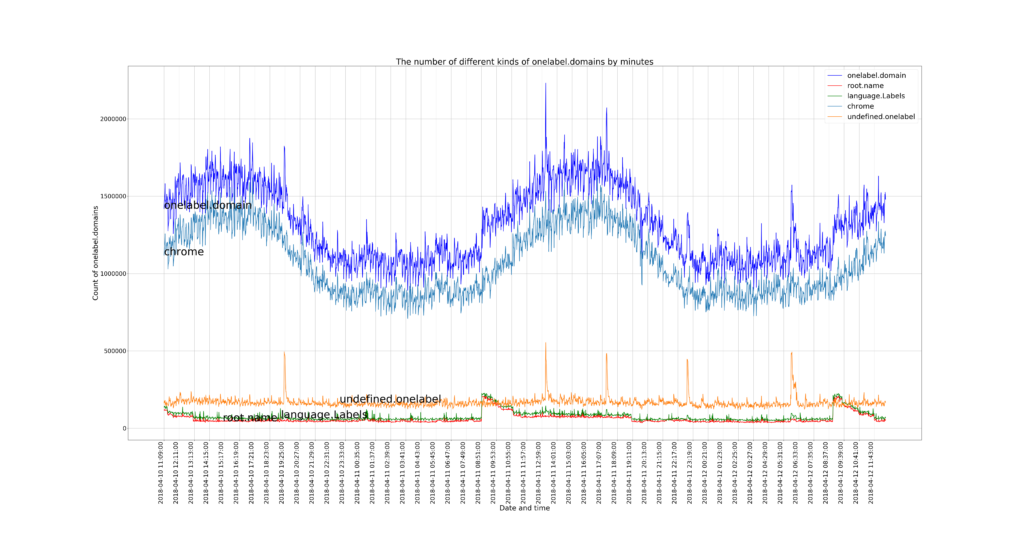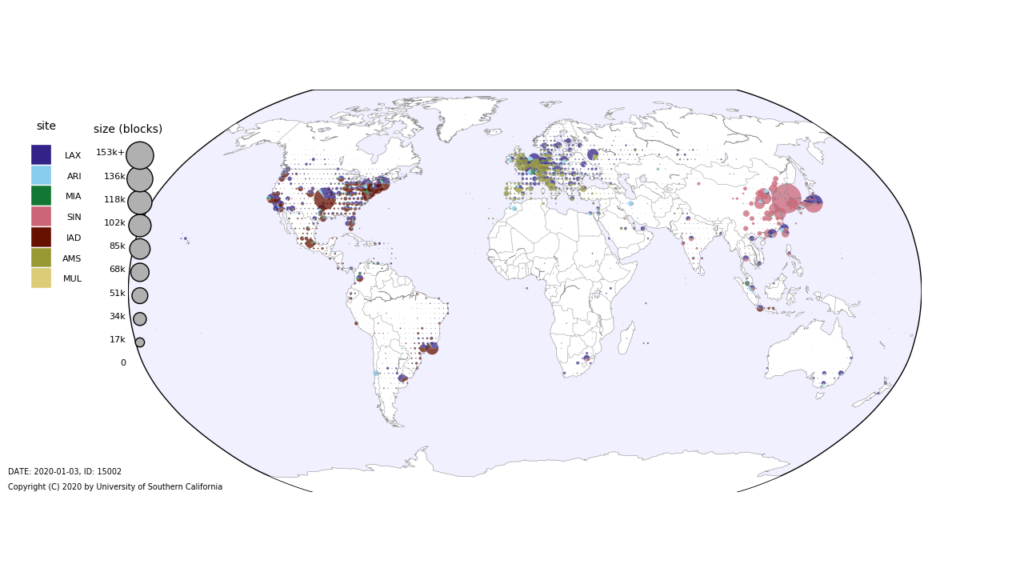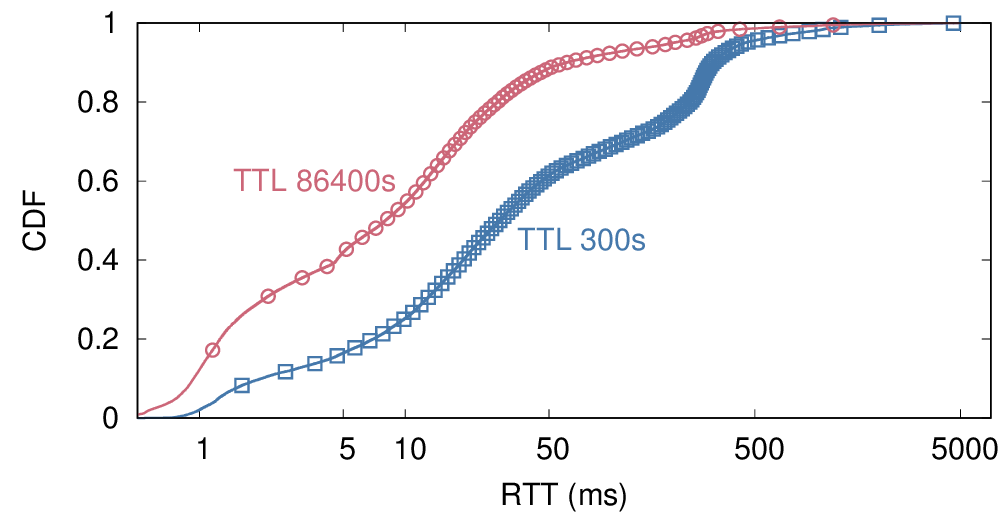During the summer of 2019, Haoyu Jiang and Wes Hardaker studied the effects of DNS traffic sent to the root serevr system by chromium-based web browsers. The results of this short research effort were posted to the APNIC blog.

During the summer of 2019, Haoyu Jiang and Wes Hardaker studied the effects of DNS traffic sent to the root serevr system by chromium-based web browsers. The results of this short research effort were posted to the APNIC blog.

B-Root, one of the 13 root DNS servers, deployed three new sites in January 2020, doubling its footprint and adding its first sites in Asia and Europe. How did this growth lower latency to users? We looked at B-Root deployment with Verfploter to answer this question. The end result was that new sites in Asia and Europe allowed users there to resolve DNS names with B-Root with lower latency (see the catchment map below). For more details please review our anycast catchment page.
B-root added 3 new sites in Singapore, Washington, DC, and Amsterdam to their three existing 3 sites in Los Angeles, Chile, and Miami. The graph below shows anycast catchments after these sites were deployed (each color in the pie charts shows traffic to a different site).

We will publish a new paper “Improving Coverage of Internet Outage Detection in Sparse Blocks” by Guillermo Baltra and John Heidemann in the Passive and Active Measurement Conference (PAM 2020) in Eugene, Oregon, USA, on March 30, 2020.
From the abstract:
There is a growing interest in carefully observing the reliability of the Internet’s edge. Outage information can inform our understanding of Internet reliability and planning, and it can help guide operations. Active outage detection methods provide results for more than 3M blocks, and passive methods more than 2M, but both are challenged by sparse blocks where few addresses respond or send traffic. We propose a new Full Block Scanning (FBS) algorithm to improve coverage for active scanning by providing reliable results for sparse blocks by gathering more information before making a decision. FBS identifies sparse blocks and takes additional time before making decisions about their outages, thereby addressing previous concerns about false outages while preserving strict limits on probe rates. We show that FBS can improve coverage by correcting 1.2M blocks that would otherwise be too sparse to correctly report, and potentially adding 1.7M additional blocks. FBS can be applied retroactively to existing datasets to improve prior coverage and accuracy.

We have released a new technical report “Peek Inside the Closed World: Evaluating Autoencoder-Based Detection of DDoS to Cloud” as an ArXiv technical report 1912.05590, also available from our website (updated 2025; prior link was: https://www.isi.edu/~hangguo/papers/Guo19a.pdf)

From the abstract of our technical report:
From the abstract:
Machine-learning-based anomaly detection (ML-based AD) has been successful at detecting DDoS events in the lab. However published evaluations of ML-based AD have only had limited data and have not provided insight into why it works. To address limited evaluation against real-world data, we apply autoencoder, an existing ML-AD model, to 57 DDoS attack events captured at 5 cloud IPs from a major cloud provider. To improve our understanding for why ML-based AD works or not works, we interpret this data with feature attribution and counterfactual explanation. We show that our version of autoencoders work well overall: our models capture nearly all malicious flows to 2 of the 4 cloud IPs under attacks (at least 99.99%) but generate a few false negatives (5% and 9%) for the remaining 2 IPs. We show that our models maintain near-zero false positives on benign flows to all 5 IPs. Our interpretation of results shows that our models identify almost all malicious flows with non-whitelisted (non-WL) destination ports (99.92%) by learning the full list of benign destination ports from training data (the normality). Interpretation shows that although our models learn incomplete normality for protocols and source ports, they still identify most malicious flows with non-WL protocols and blacklisted (BL) source ports (100.0% and 97.5%) but risk false positives. Interpretation also shows that our models only detect a few malicious flows with BL packet sizes (8.5%) by incorrectly inferring these BL sizes as normal based on incomplete normality learned. We find our models still detect a quarter of flows (24.7%) with abnormal payload contents even when they do not see payload by combining anomalies from multiple flow features. Lastly, we summarize the implications of what we learn on applying autoencoder-based AD in production.problme?Machine-learning-based anomaly detection (ML-based AD) has been successful at detecting DDoS events in the lab. However published evaluations of ML-based AD have only had limited data and have not provided insight into why it works. To address limited evaluation against real-world data, we apply autoencoder, an existing ML-AD model, to 57 DDoS attack events captured at 5 cloud IPs from a major cloud provider. To improve our understanding for why ML-based AD works or not works, we interpret this data with feature attribution and counterfactual explanation. We show that our version of autoencoders work well overall: our models capture nearly all malicious flows to 2 of the 4 cloud IPs under attacks (at least 99.99%) but generate a few false negatives (5% and 9%) for the remaining 2 IPs. We show that our models maintain near-zero false positives on benign flows to all 5 IPs. Our interpretation of results shows that our models identify almost all malicious flows with non-whitelisted (non-WL) destination ports (99.92%) by learning the full list of benign destination ports from training data (the normality). Interpretation shows that although our models learn incomplete normality for protocols and source ports, they still identify most malicious flows with non-WL protocols and blacklisted (BL) source ports (100.0% and 97.5%) but risk false positives. Interpretation also shows that our models only detect a few malicious flows with BL packet sizes (8.5%) by incorrectly inferring these BL sizes as normal based on incomplete normality learned. We find our models still detect a quarter of flows (24.7%) with abnormal payload contents even when they do not see payload by combining anomalies from multiple flow features. Lastly, we summarize the implications of what we learn on applying autoencoder-based AD in production.
This technical report is joint work of Hang Guo and John Heidemann from USC/ISI and Xun Fan, Anh Cao and Geoff Outhred from Microsoft
Mozilla announced the creation of a “use-application-dns.net” “Canary Domain” that could be configured within ISPs to disable Firefox’s default use of DNS over HTTPS. On 2019/09/21 Wes Hardaker created a RIPE Atlas measurement to study resolvers within ISPs that had been configured to return an NXDOMAIN response. This measurement is configured to have 1000 Atlas probes query for the use-application-dns.net name once a day.
The full description of methodology is on Wes’ ISI site, which should receive regular updates to the graph.

On November 14 we had a group lunch near ISI to celebrate the completion of Joao Ceron’s visit from the University of Twente as a visiting scholar, to welcome Asma Enayet to the group as a new PhD student, and to welcome Hang Guo’s son into the world. (Hang was understandably not able to make the lunch.) Happy Thanksgiving to all!

We will publish a new paper “Identifying Important Internet Outages” by Ryan Bogutz, Yuri Pradkin, and John Heidemann, in the Sixth National Symposium for NSF REU Research in Data Science, Systems, and Security in Los Angeles, California, USA, on December 12, 2019.
From the abstract:

Today, outage detection systems can track outages across the whole IPv4 Internet—millions of networks. However, it becomes difficult to find meaningful, interesting events in this huge dataset, since three months of data can easily include 660M observations and thousands of outage events. We propose an outage reporting system that sifts through this data to find the most interesting events. We explore multiple metrics to evaluate interesting”, reflecting the size and severity of outages. We show that defining interest as the product of size by severity works well, avoiding degenerate cases like complete outages affecting a few people, and apparently large outages that affect only a small fraction of people in an area. We have integrated outage reporting into our existing public website (https://outage.ant.isi.edu) with the goal of making near-real-time outage information accessible to the general public. Such data can help answer questions like “what are the most significant outages today?”, did Florida have major problems in an ongoing hurricane?”, and
“are there power outages in Venezuela?”.
The data from this paper is available publicly and in our website. The technical report ISI-TR-735 includes some additional data.
We have released a new technical report “Improving the Optics of the Active Outage Detection (extended)”, by Guillermo Baltra and John Heidemann, as ISI-TR-733.
From the abstract:

There is a growing interest in carefully observing the reliability of the Internet’s edge. Outage information can inform our understanding of Internet reliability and planning, and it can help guide operations. Outage detection algorithms using active probing from third parties have been shown to be accurate for most of the Internet, but inaccurate for blocks that are sparsely occupied. Our contributions include a definition of outages, which we use to determine how many independent observers are required to determine global outages. We propose a new Full Block Scanning (FBS) algorithm that gathers more information for sparse blocks to reduce false outage reports. We also propose ISP Availability Sensing (IAS) to detect maintenance activity using only external information. We study a year of outage data and show that FBS has a True Positive Rate of 86%, and show that IAS detects maintenance events in a large U.S. ISP.
All data from this paper will be publicly available.
Wes Hardaker gave two presentations at DNS-OARC on November 1st, 2019. The first was a presentation about the previously announced “Cache me if you can” paper, which is on youtube, and the slides are available as well. The second talk presented Haoyu Jiang’s work during the summer of 2018 on analyzing DNS B-Root traffic during the 2018 DITL data for levels of traffic sent by the Chrome web browser, levels of traffic associated with different languages, and levels of traffic sent by different label lengths. It is available on youtube with the slides here.
We will publish a new paper “Cache Me If You Can: Effects of DNS Time-to-Live” by Giovane C. M. Moura, John Heidemann, Ricardo de O. Schmidt, and Wes Hardaker, in the ACM Internet Measurements Conference (IMC 2019) in Amsterdam, the Netherlands.
From the abstract:

DNS depends on extensive caching for good performance, and every DNS zone owner must set Time-to-Live (TTL) values to control their DNS caching. Today there is relatively little guidance backed by research about how to set TTLs, and operators must balance conflicting demands of caching against agility of configuration. Exactly how TTL value choices affect operational networks is quite challenging to understand due to interactions across the distributed DNS service, where resolvers receive TTLs in different ways (answers and hints), TTLs are specified in multiple places (zones and their parent’s glue), and while DNS resolution must be security-aware. This paper provides the first careful evaluation of how these multiple, interacting factors affect the effective cache lifetimes of DNS records, and provides recommendations for how to configure DNS TTLs based on our findings. We provide recommendations in TTL choice for different situations, and for where they must be configured. We show that longer TTLs have significant promise in reducing latency, reducing it from 183ms to 28.7ms for one country-code TLD.
We have also reported on this work at the RIPE and APNIC blogs.